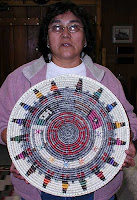
Navajo Basket Weaver Mary Holiday Black
Having gone through many phases in my life, I have finally come to the conclusion that hozho is an idea that deserves a larger role in my day-to-day activities. Unfortunately, this realization did not came quickly or easily. Although Barry has been discoursing on this subject for years, until lately I had not paid sufficient attention.
A few months ago, Jana came home with a copy of Amy Irvine’s latest book, Trespass: Living at the Edge of the Promised Land. I had been told that Ms. Irvine’s autobiography described her struggle to find balance in this rugged red rock desert populated with equally rugged individuals. Since the story is based on contemporary events, involves many characters I know from my youth and reportedly had a connection with my recent commitment to introduce hozho more prominently into my life, I was extremely interested in the narrative.
The memoir describes the author’s attempt to establish herself in the small southeastern Utah town of Monticello; a community where my ties run strong and deep. I had hoped to find some insight that might help me address numerous environmental, cultural, political and religious questions that have confounded me over the years. Despite what I had been led to believe, I did not discover much balance in the writer’s description of the people of southeastern Utah. Neither did I find a way to begin addressing any of the issues that have been pressing in on me for some time. The book did, however, lead me to look more profoundly into hozho.
Having finished what for me was a divisive manuscript, I better understood the ideal that there cannot be real, long-term progress without compromise; not the kind that involves caving in and abandoning your principles, but the type that requires finding a middle road that all parties can safely, if not fully comfortably, travel.
Although I know it is all too common, as a young man, I could see the world only as black or white, right or wrong. As I have grown older, however, I have more and more trouble distinguishing between the two extremes. I often find myself trying to justify both sides of the argument, searching for common ground.

Navajo Hozho Basket by Peggy Black
Those who know my background, contend my formal training is the reason I see the world as polychrome. I, however, believe it is Twin Rocks that has caused the philosophical shift. The trading post has taught me that the polar extremes are inconvenient and uncomfortable places to reside, and that the, “It’s my way or the highway” philosophy only leads to additional conflict.
For many of our artists, crisis is a way of life. Consequently, things at Twin Rocks are in a constant state of flux. So, it seems that flexibility; a focus on compromise, balance, peace and harmony, hozho, are inherent in the trading post model. Living the trading post life often requires an earnest attempt to understand the maker’s needs when negotiating the value of a Navajo rug, patience when settling the selling price for a turquoise bracelet and empathy when determining just how much to help an artist out of a difficult situation when it threatens to upset the delicate state of our own circumstances.
In attempting to comprehend both sides of the issues, I am often reminded of the Lone Ranger and his trusty sidekick Tonto, who one evening were lying in their bedrolls not far from the fading fire, staring into the night sky. After a while Tonto asked his friend, “Kimosabe, what you see?” Taking a long time to consider his response, the Lone Ranger finally said, “I see numerous constellations, the Milky Way and . . ., well . . . eternity. In those stars I see the hand of God, His divine plan and tremendous beauty. What do you see Tonto?” Also carefully considering his reply, Tonto said, “Kimosabe, me see someone stole tent.”
With Warm Regards,
Steve, Barry and the Team.
Copyright 2008 Twin Rocks Trading Post

No comments:
Post a Comment